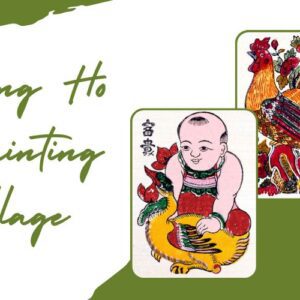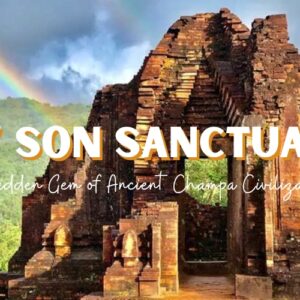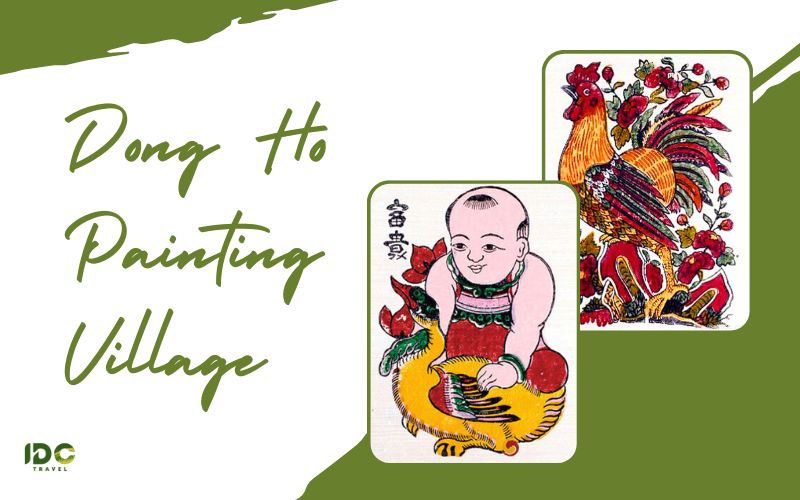
Dong Ho paintings, also known as Dong Ho folk woodcut paintings, indeed hold a significant place in Vietnamese culture. They are not only a beautiful form of art, but also a cherished cultural tradition that local communities strive to preserve. If you are interested in Vietnamese cultural traditions and specifically in Dong Ho paintings, IDC Travel can provide you with a comprehensive guide to Dong Ho painting village. They can offer insights into the history, techniques, and significance of Dong Ho paintings. Exploring the village will allow you to immerse yourself in the vibrant world of this traditional art form and witness craftsmanship firsthand. Whether you are an art enthusiast or simply curious about Vietnamese traditions, delving into the world of Dong Ho paintings will undoubtedly enrich your cultural experience.
Location of Dong Ho Painting Village
Dong Ho painting village, also known as Mai Village, is located in the Thuan Thanh district of Bac Ninh Province in Vietnam. The village lies on the southern bank of the Duong River, approximately 35 kilometers east of Hanoi, the capital city of Vietnam. The village is renowned for its traditional craft of making Dong Ho paintings. These folk paintings are famous for their unique style and vibrant colors. They often depict scenes from daily life, folklore, and traditional stories. Dong Ho paintings are created using traditional techniques and natural materials, making them a valuable part of Vietnamese cultural heritage.
History of Dong Ho Painting Village
According to historical accounts, the origins of Dong Ho paintings can be traced back to the 11th century under the Ly Dynasty, while some researchers attribute it to the Le Dynasty. Initially, the villagers in Dong Ho produced black-and-white prints of woodcuts. However, as the craft gained popularity, artisans began incorporating different colors into the paintings, a characteristic that has been preserved to this day.
In the past, the production of Dong Ho paintings in the village of Dong Ho involved the participation of nearly all its villagers. Each person had a specific role in the process, contributing to the overall production of these folk paintings. Manufacturing the special “Diep” papers was an essential step in the production of Dong Ho paintings. The villagers were skilled in making these handmade papers, which had unique qualities that were suitable for the printing process. Sourcing natural colors was another crucial aspect of the craft. The craftsmen would gather materials from nature, such as tree bark, leaves, and flowers, to create vibrant and organic pigments for the paintings. Carving woodblocks was a specialized skill performed by artisans in Dong Ho. These woodblocks were intricately carved with the desired images and designs, serving as the printing plates for the paintings. Besides, the printing process itself involved applying ink to the woodblocks and pressing them onto the “Diep” papers to transfer the images. This meticulous process required precision and expertise.
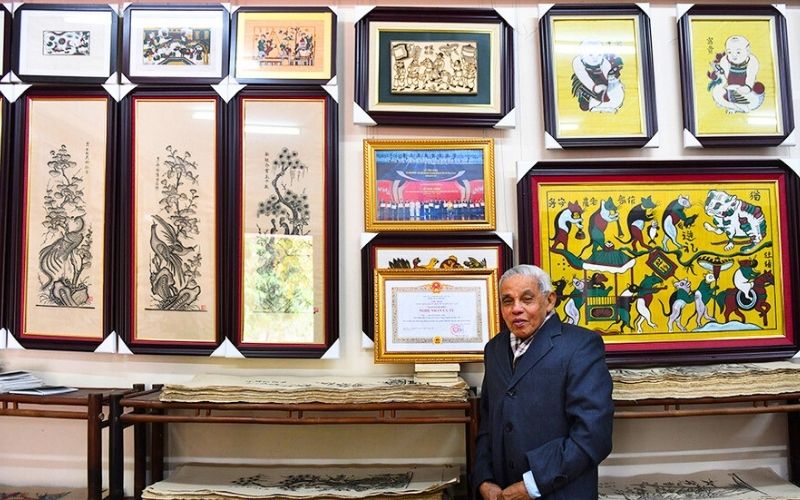
Artist Nguyen Dang Che and his gallery
Before 1945, Dong Ho paintings enjoyed significant popularity, and the demand for them provided a livelihood for over 150 families in the village. However, with the advent of modern Vietnamese culture and the influence of other art forms, the demand for Dong Ho paintings started to decline rapidly. As a result, many craftsmen were compelled to abandon their craft and seek alternative means of livelihood. The decline in demand and the changing dynamics of society posed significant challenges to the continuation of this traditional art form.
Despite these challenges, the dedication and perseverance of a few families, such as the Nguyen Huu Sam and Nguyen Dang Che families, have ensured that the legacy of the Dong Ho painting is preserved. They continue to practice the craft, keeping the tradition alive and sharing its beauty with the world. Currently, according to information from the Ministry of Culture, Sports and Tourism, the Prime Minister has agreed to submit the national dossier to UNESCO for reviewing and putting “Dong Ho folk painting profession” on the list of intangible cultural heritage in need of urgent protection.
>>> Visit Dong Ho Painting Village and other enchanting cultural sites in Bac Ninh with our 1-day tour from Hanoi.
What Makes Dong Ho Painting Special?
In reality, creating a single Dong Ho woodcut painting is a labor-intensive process that requires a significant amount of time and effort. It can take several months to complete a single painting, showcasing the dedication and meticulousness of the craftsmen involved. Traditionally, craftsmen would start the production process six or seven months prior to the Tet holiday (Vietnamese New Year) because these paintings were in high demand during that time.
Creating a Dong Ho painting involves the use of multiple woodblocks. Each woodblock contains a specific design element or color that, when combined with other blocks, contributes to the overall composition of the painting. The use of multiple blocks allows for the layering of different colors and details, adding depth and complexity to the artwork. The woodblocks themselves are considered valuable assets to the local craftsmen. They are carefully preserved and passed down through generations within families. Some families in Dong Ho still possess ancient woodblocks that have been used for generations, maintaining the authenticity and traditional techniques of Dong Ho painting.
The retention of these ancient woodblocks not only symbolizes the continuity of the craft but also serves as a valuable resource for future generations to learn and carry forward the art form. The intricate designs on the woodblocks represent the creativity of craftsmen and the artistic meaning of Dong Ho Painting.
The Meaning of Dong Ho Painting
Dong Ho folk paintings are known for their diverse themes and their vibrant portrayal of various aspects of life. These paintings capture legendary characters, everyday scenes of local life, countryside landscapes, and wishes for prosperity. The subjects depicted in Dong Ho Paintings range from social commentary to folklore and auspicious symbols, such as Jealous Figh (lampooning the polygamous system), Teacher (Depicting old educational practices), and Saint Giong (Praising the legendary character of Saint Giong).
Dong Ho paintings are particularly popular during the Tet holiday, which is the Vietnamese New Year celebration. They are often referred to as Tet paintings or spring paintings. People purchase these paintings to decorate their houses during this festive time, believing that they bring good luck and prosperity for the coming year.
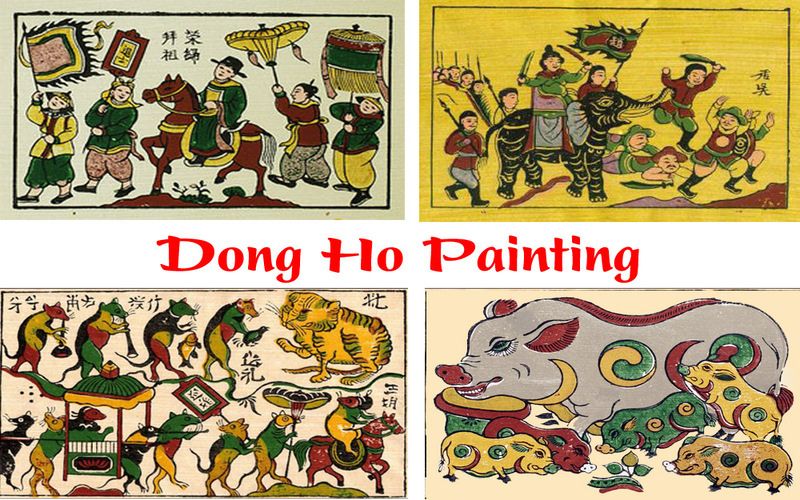
Folklore and auspicious symbols in Dong Ho Paintings
Among the best-selling paintings during Tet are “Herds of Pigs” and “Flocks of Chickens”. These paintings symbolize wishes for happiness, abundance, and success in the New Year. Humorous content is also present in some Dong Ho paintings, such as the “Rat’s Wedding Dong Ho painting”, which adds a touch of whimsy to the collection. In addition to single paintings, Dong Ho paintings also come in couplets or quartets, where multiple paintings are displayed together to convey a complete message. For example, the Vietnamese words Vinh Hoa (Eminence) and Phu Quy (Prosperity and Honor) are often depicted side by side, representing aspirations for a successful and honorable life.
Dong Ho Paintings are not only beautiful works of art but also carry cultural and symbolic significance. They also become souvenir gifts for friends and relatives that cannot be missed by every domestic and foreign tourist when visiting Dong Ho painting village.
How to Make a Dong Ho Painting?
Dong Ho Paintings possess a special charm attributed to their unique manufacturing process and materials. The creation of these paintings involves a manual printing process that combines the art of woodblock carving and the meticulous arrangement of colors.
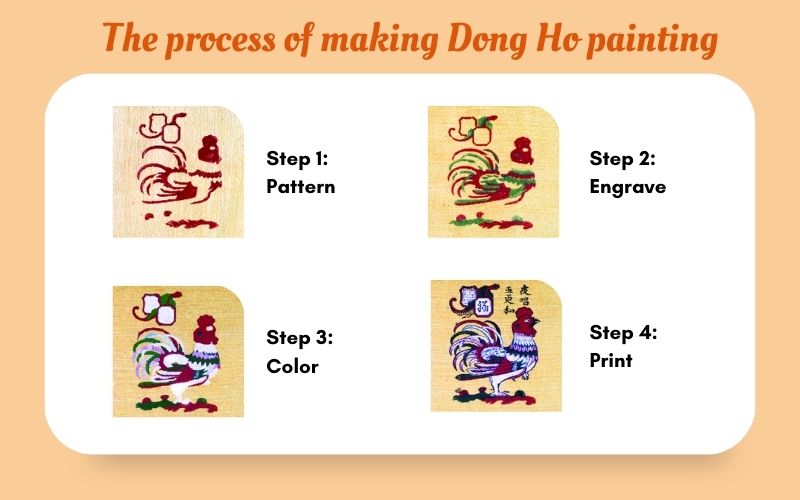
The process of making Dong Ho Painting
To produce a single Dong Ho painting, craftsmen begin by intricately carving different shapes onto wooden blocks. These blocks serve as the printing stamps. Paint is then applied to the carved blocks, which are pressed onto specially crafted “Diep” paper. The production of “Diep” paper is a time-consuming and meticulous task. Craftsmen soak the bark of ‘do’ trees in water for several months. The soaked bark is then mixed with powders made from seashells and glutinous rice to create sheets of paper.
The colors used in Dong Ho Paintings are equally special. They are not artificial but derived from various natural materials. For example, burnt bamboo leaves produce a black color, cajuput leaves provide a green hue, and copper rust is used for blue. Each color requires a separate woodblock, and the layers of color are printed precisely, without overlapping. The printing process starts with red, followed by green, yellow, white, and black. Only one color can be printed per day.
To ensure longevity and protection, the entire painting is coated with a layer of sticky rice paste. The painting is then left to dry under the sun. This method preserves the original colors of the Dong Ho painting for an extended period. The intricate process and use of natural materials contribute to the distinctive beauty and longevity of Dong Ho Paintings.
Some Popular Paintings of Dong Ho Village
Rat’s Wedding
“Rat’s Wedding” holds a distinct significance among the paintings of Dong Ho village. This particular artwork depicts the theme of embezzlement and accepting bribes, using the metaphor of a cat preoccupied with catching birds and fish, neglecting its primary duty of catching mice. Due to its profound meaning, “Rat Wedding” is often purchased and displayed in offices and homes as a reminder, warning, and teaching tool for those in positions of authority. The painting serves as a visual representation that encourages ethical conduct. The deep meaning conveyed by “Rat’s Wedding” contributes to its significance and popularity within the Dong Ho painting tradition.
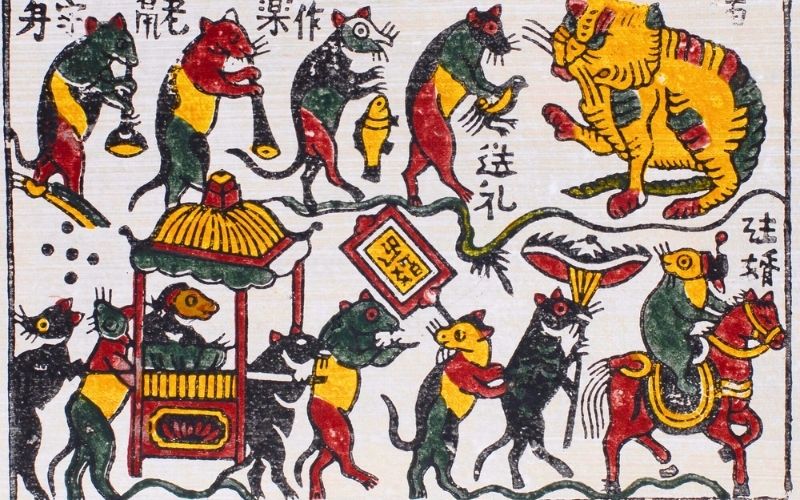
Rat’s Wedding Dong Ho Painting
Vinh Hoa – Phu Quy
The pair of “Vinh Hoa – Phu Quy” represents the aspirations for a prosperous and honorable life. “Vinh Hoa” symbolizes eminence, while “Phu Quy” signifies prosperity and honor. Together, they express the desire to congratulate and pray for a family’s abundance and wealth. The combination of “Vinh Hoa – Phu Quy” as a pair adds a sense of completeness and harmony to the overall message, enhancing the symbolic significance of these Dong Ho paintings. During the Tet holidays in Vietnam, it is common for people to purchase and hang a pair of “Vinh Hoa – Phu Quy” paintings in their homes. The presence of these paintings during this festive time is believed to bring good luck, blessings, and a prosperous life to the family.
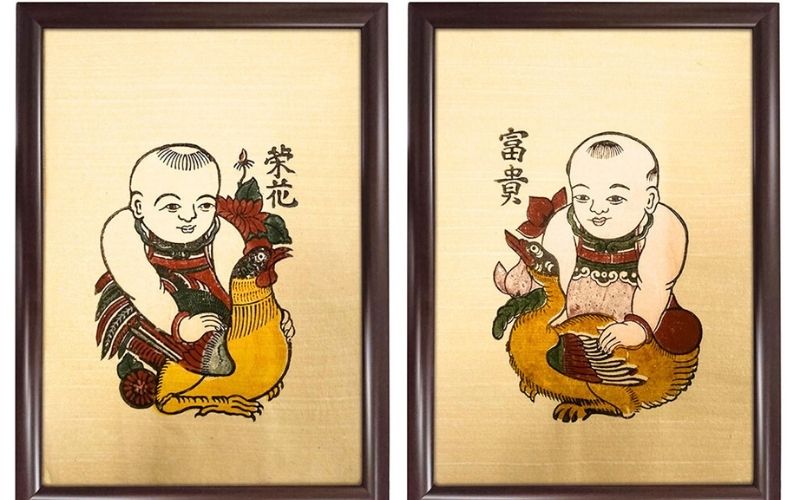
Eminence, Prosperity, and Honor
Yin and Yang Pigs
The depiction of pigs in Dong Ho folk paintings holds great significance and is considered one of the most well-formed representations of pigs in Vietnamese art. Pigs portrayed in Dong Ho Paintings symbolize prosperity and abundance. They carry a special meaning of affluence and are often associated with wishes for a prosperous new year. The image of a pig in these paintings evokes positive sentiments and aspirations for wealth and good fortune. The meticulous artistry and attention to detail in representing pigs in Dong Ho paintings contribute to their appeal and convey the cultural significance attached to these animals in Vietnamese tradition.
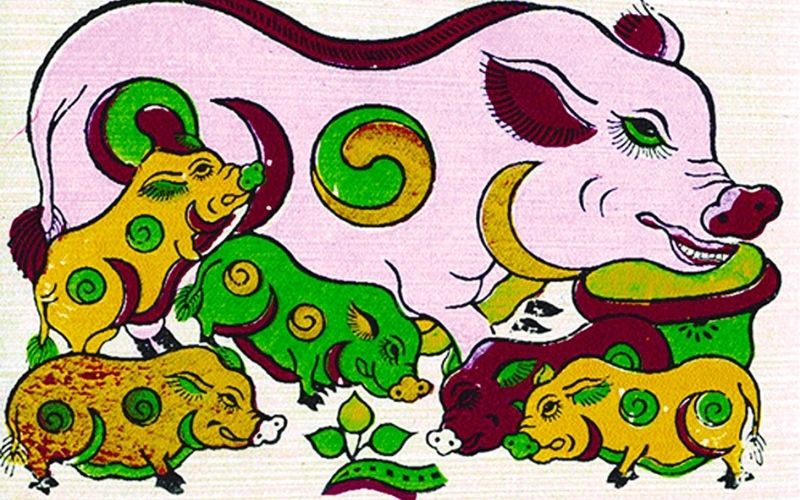
Yin and yang pigs
Feed buffalo and play the flute
The painting described evokes a sense of serenity and tranquility. The upright lotus leaf, resembling an umbrella, and the buffalo craning its neck to enjoy the sound of the flute create a picturesque scene that evokes a peaceful and quiet life. The lotus is a revered flower in Vietnamese culture, symbolizing purity, enlightenment, and resilience. The image of a lotus leaf standing upright like an umbrella adds to the sense of calmness and harmony in the scene. The buffalo, often associated with rural life in Vietnam, represents hard work, strength, and a close connection to nature. Its posture of craning its neck to listen to the flute music portrays a moment of pure enjoyment and immersion in the beauty of sound and surroundings.
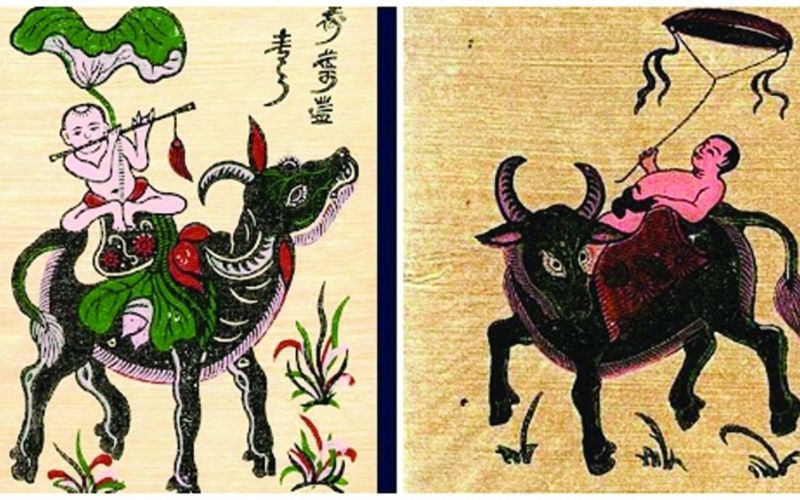
Feed buffalo and play the flute
Dong Ho Painting Village offers a wonderful opportunity for tourists to immerse themselves in the beauty of this unique traditional Vietnamese folk art. Including a visit to Dong Ho Painting Village during a Bac Ninh tour would be a great addition to your itinerary. Exploring the village will allow you to witness the exquisite craftsmanship of the Dong Ho paintings, marvel at their vibrant colors and intricate details, and gain insights into the cultural significance behind each artwork. If you’re planning to visit Dong Ho Painting Village or have any questions or concerns regarding your trip, feel free to contact us for more details.
